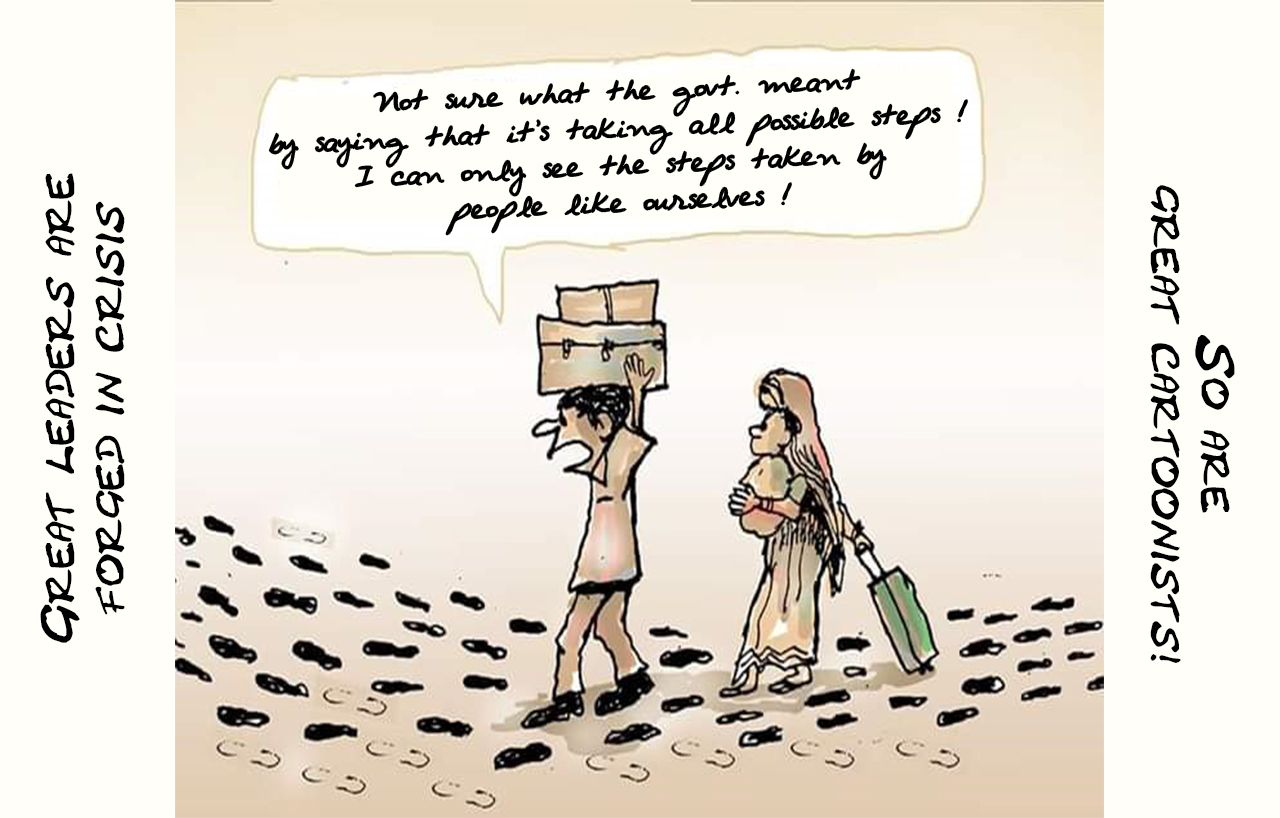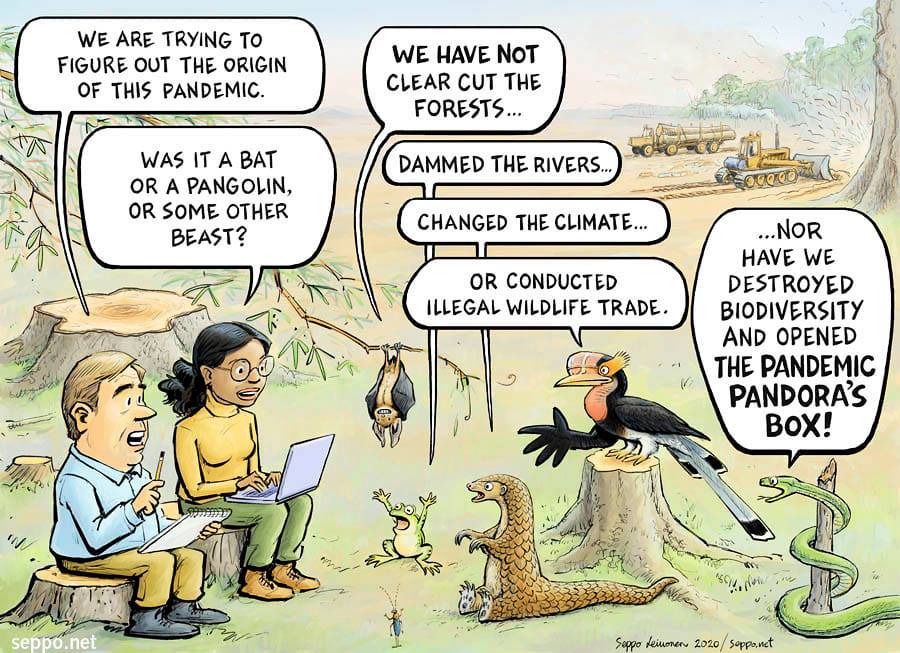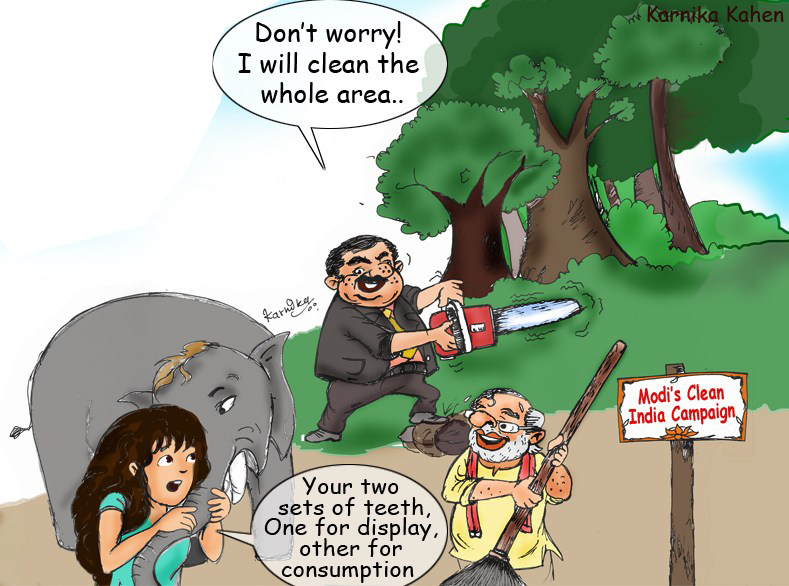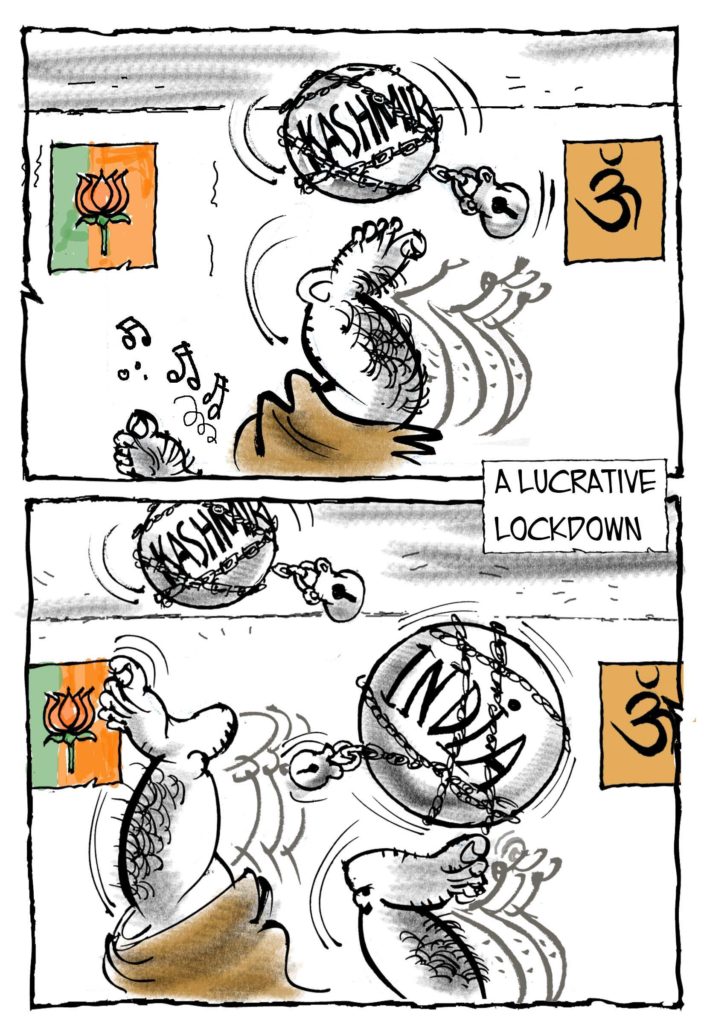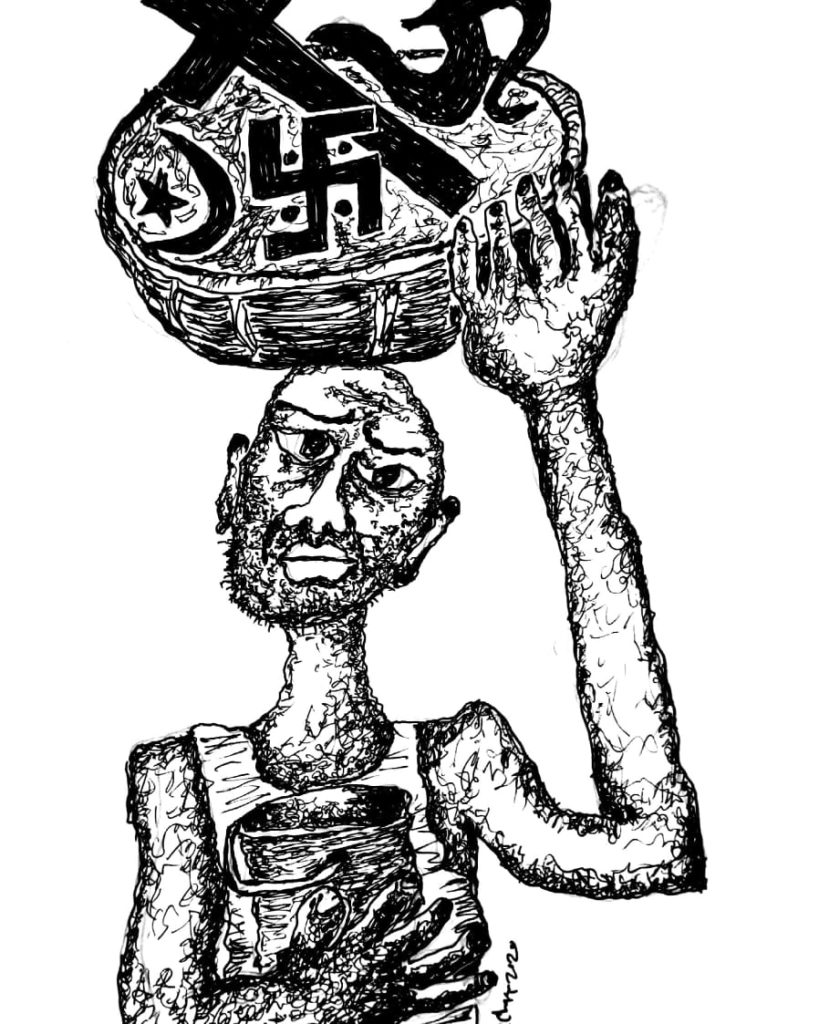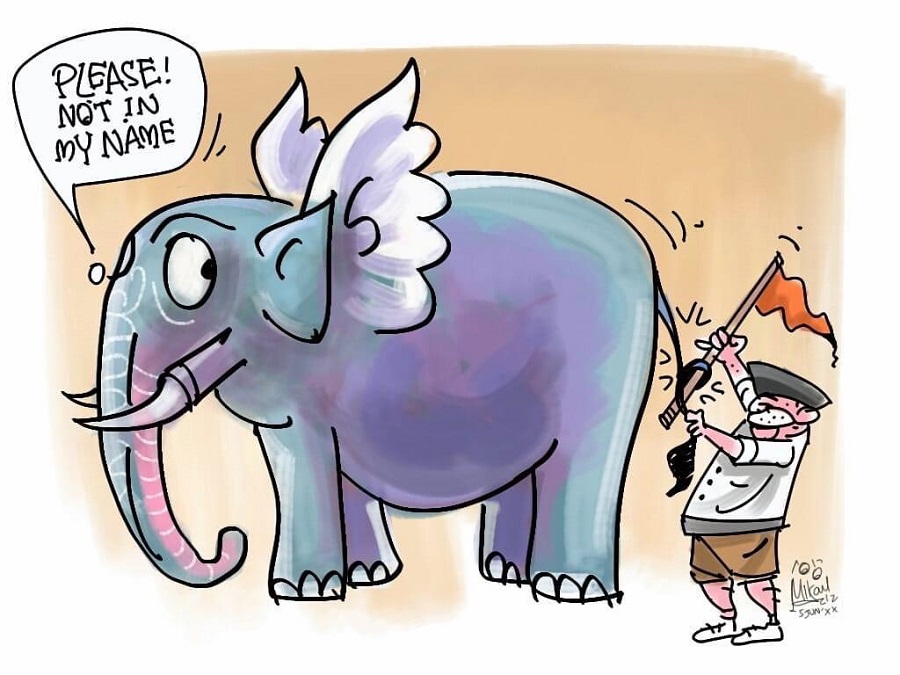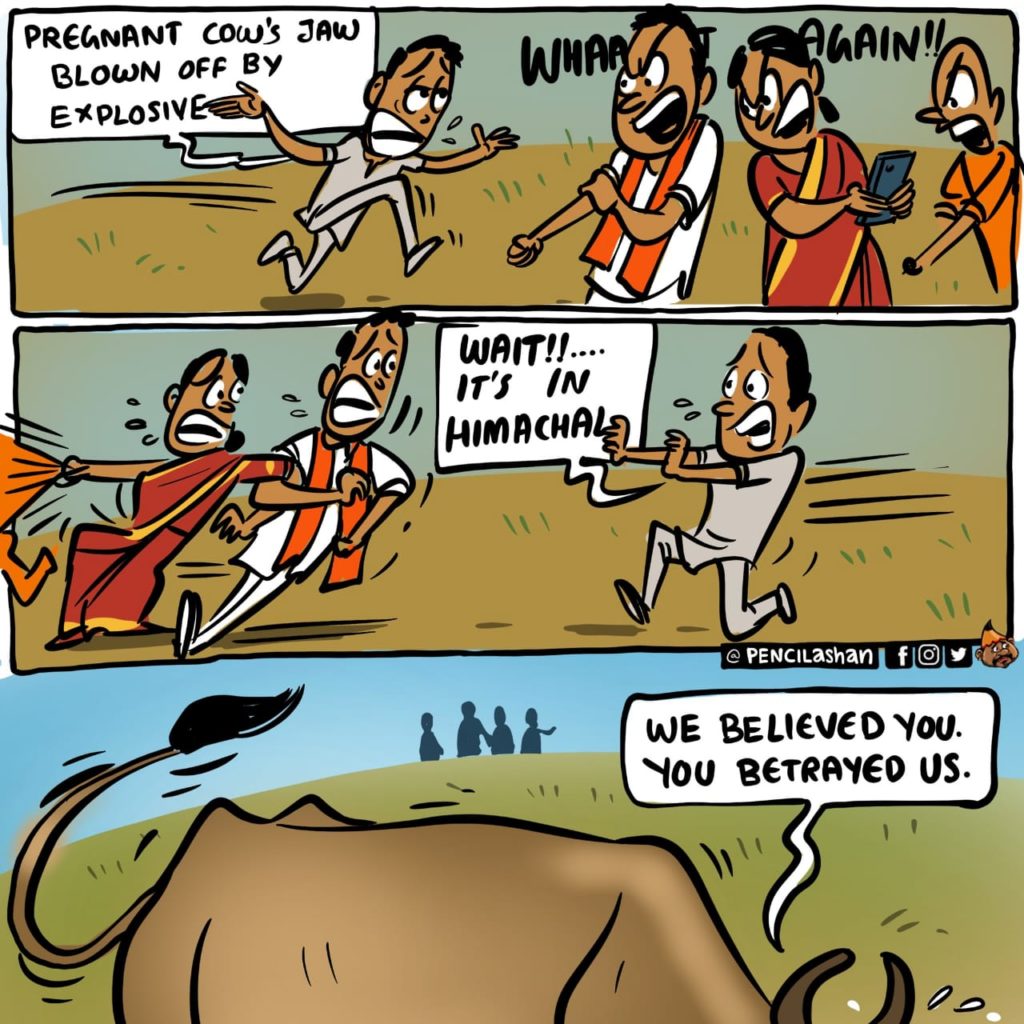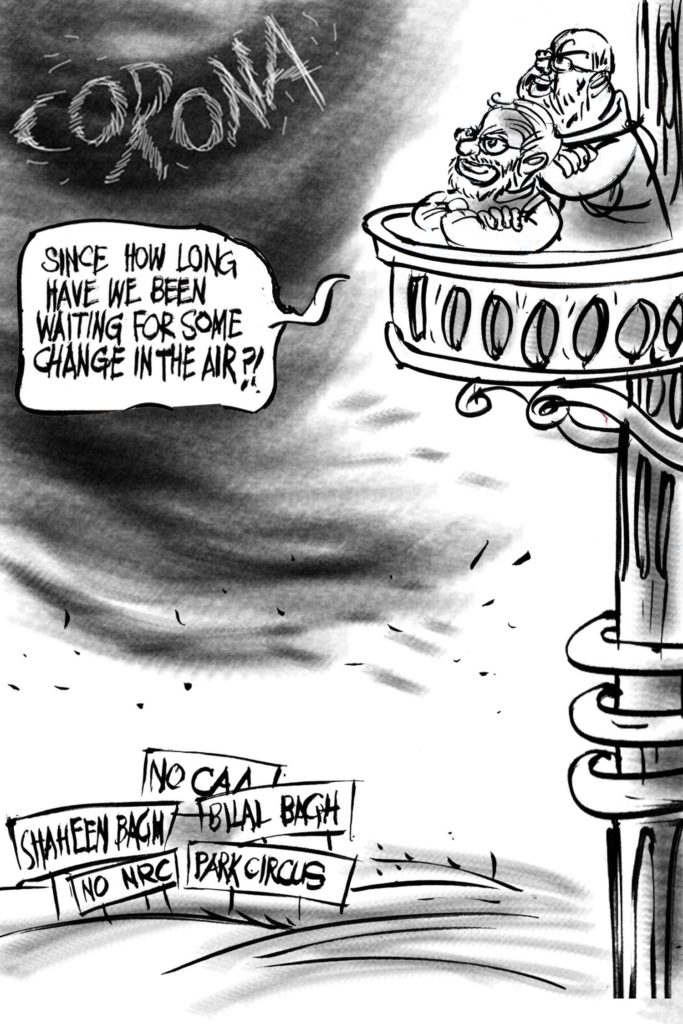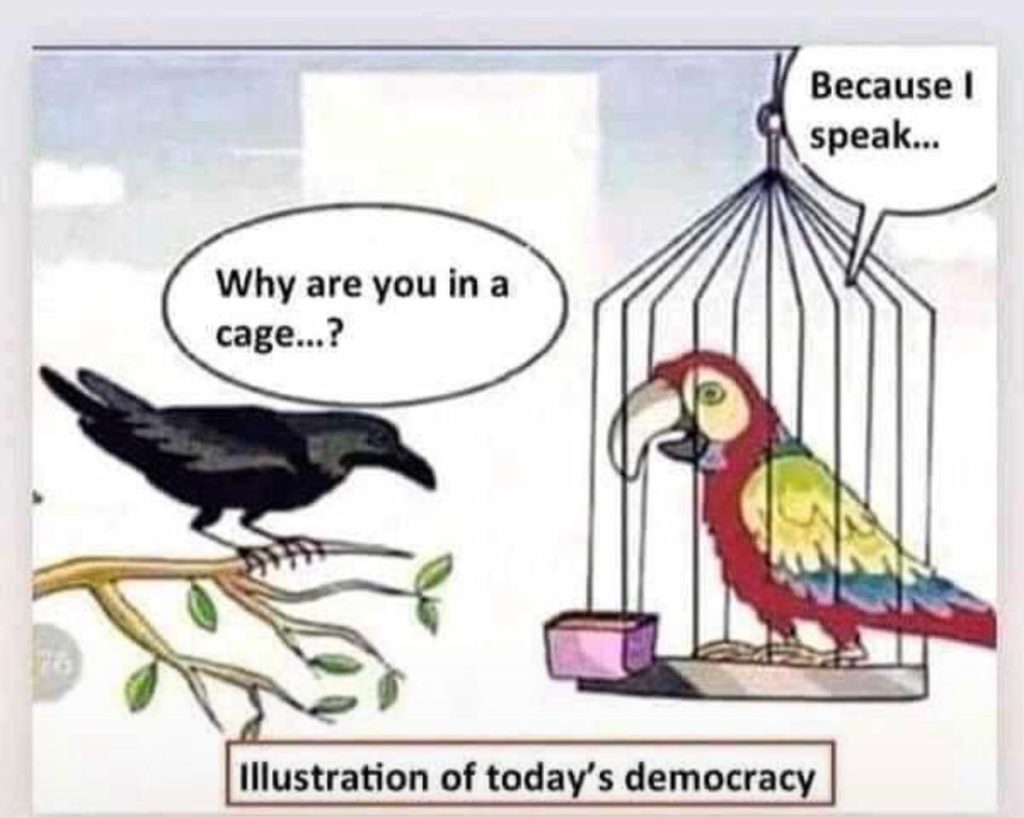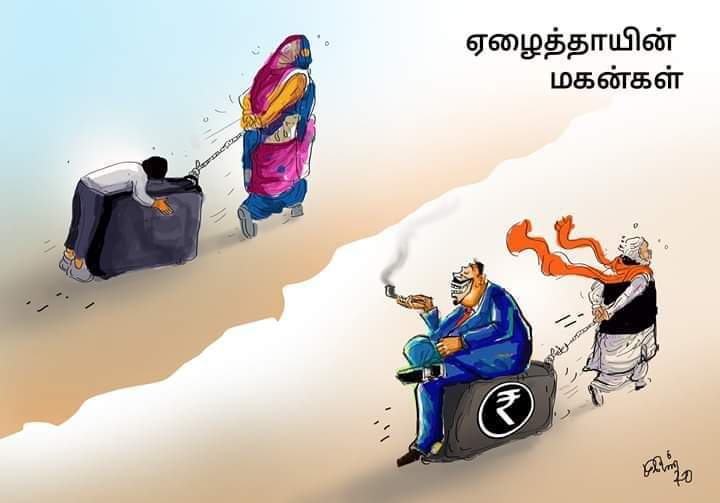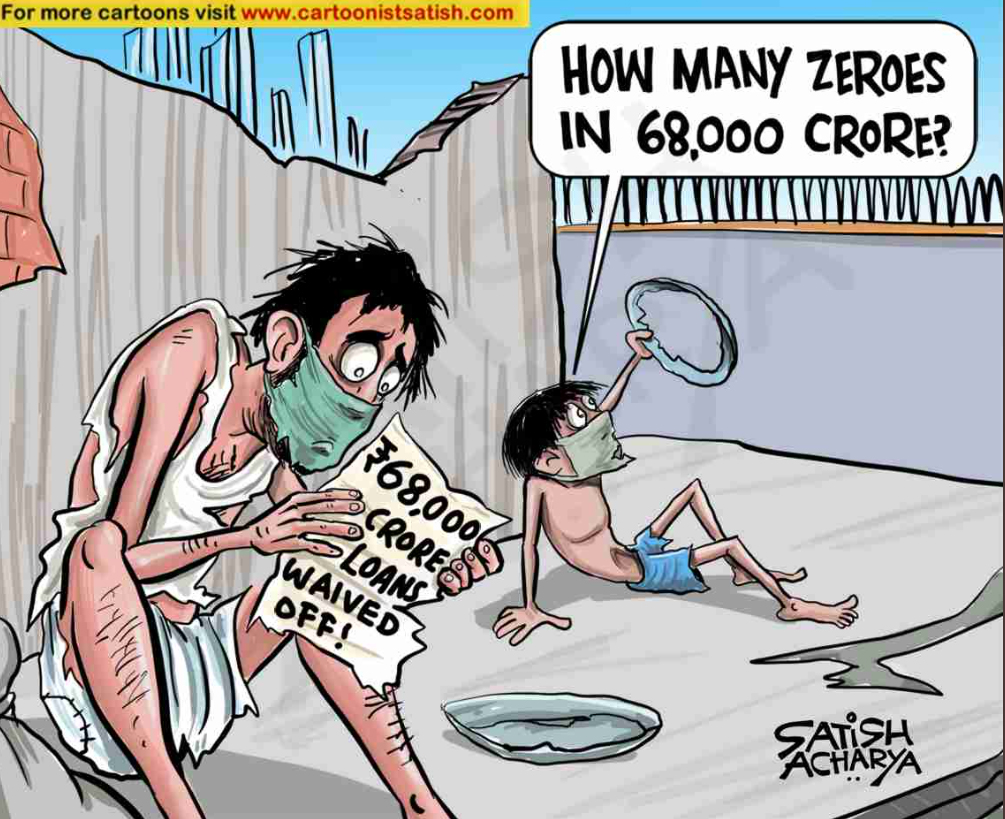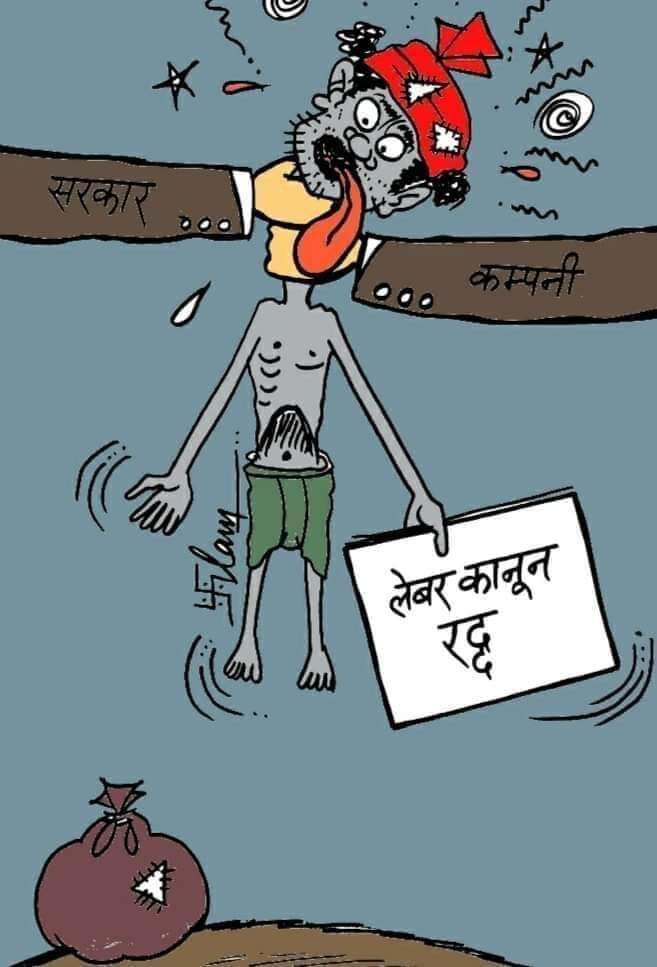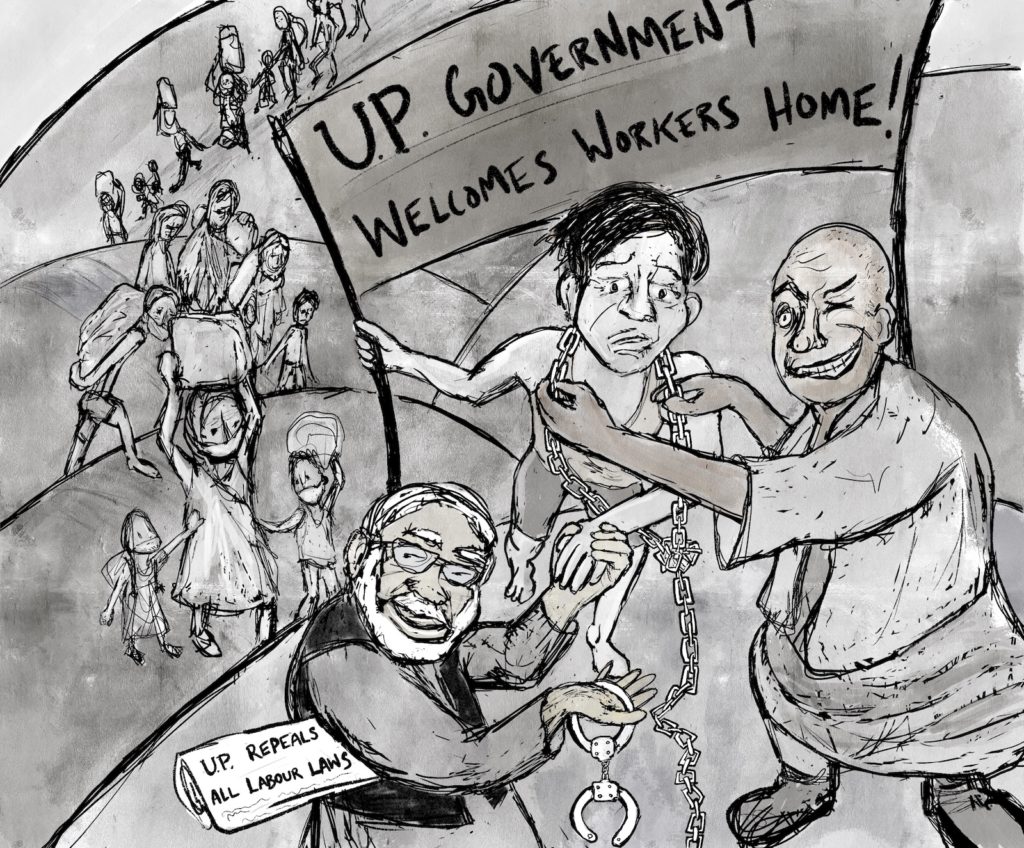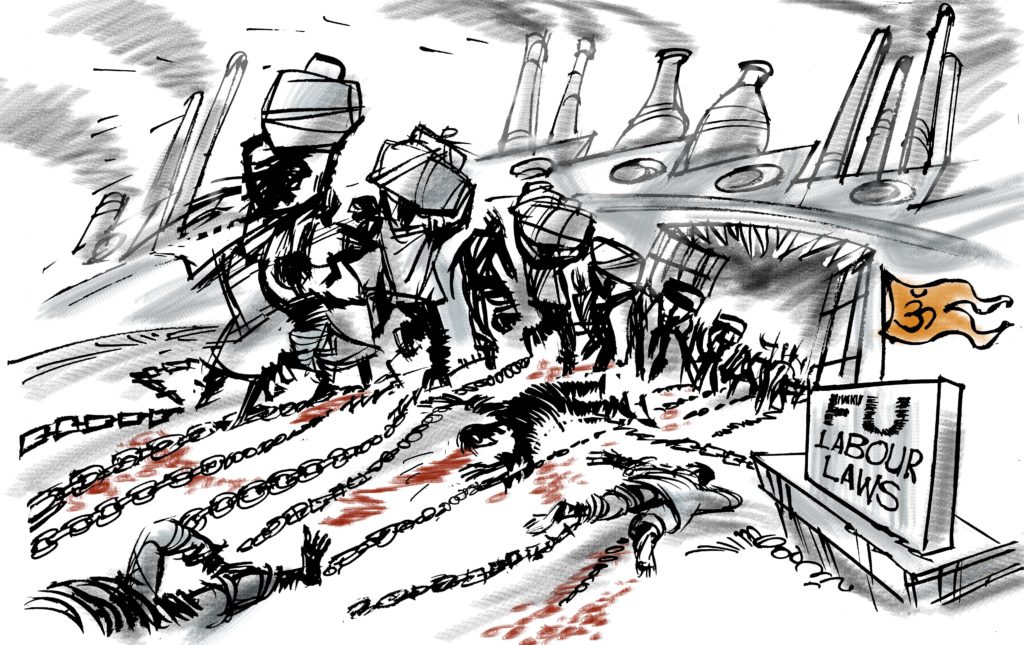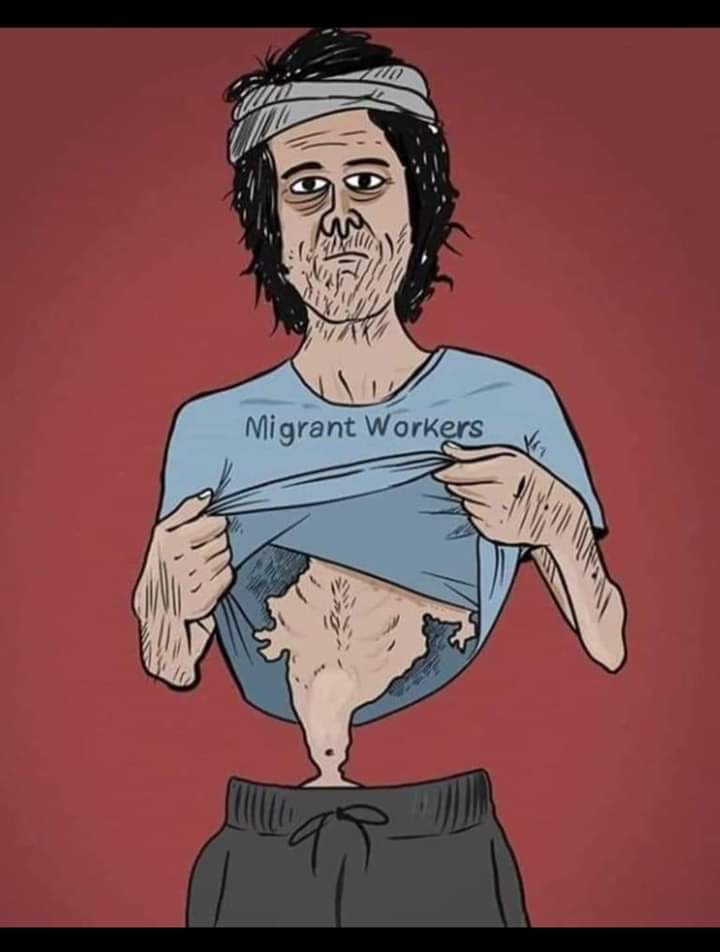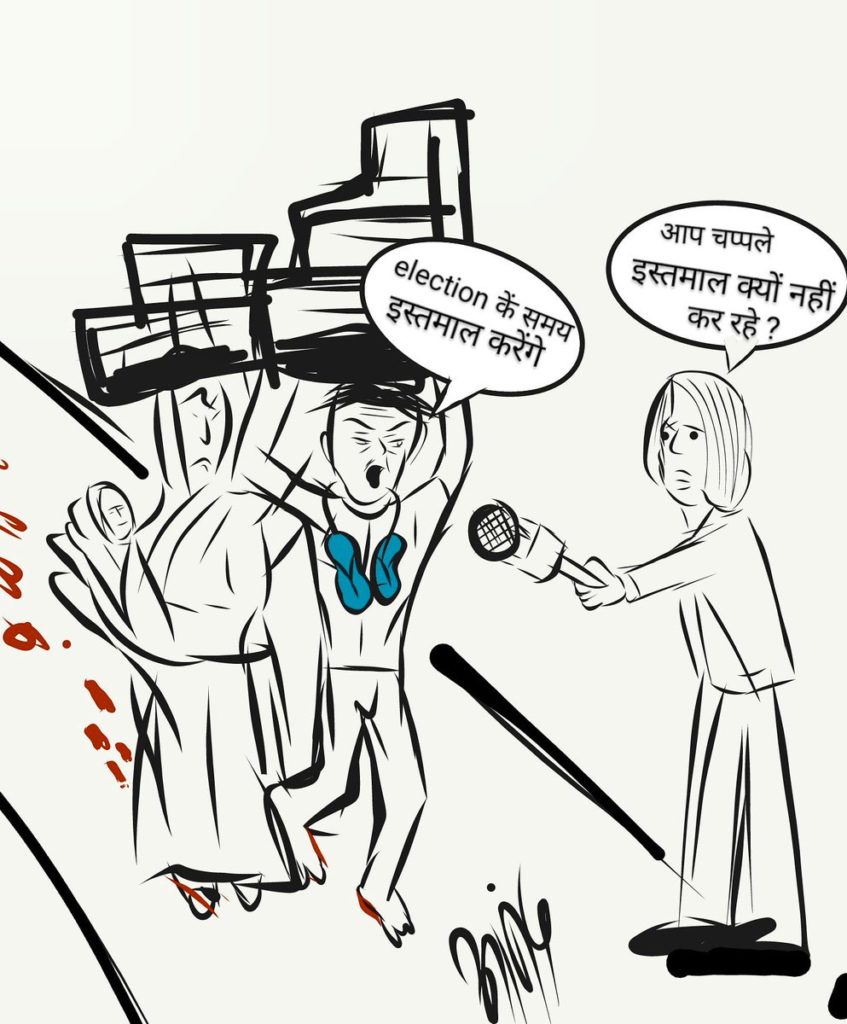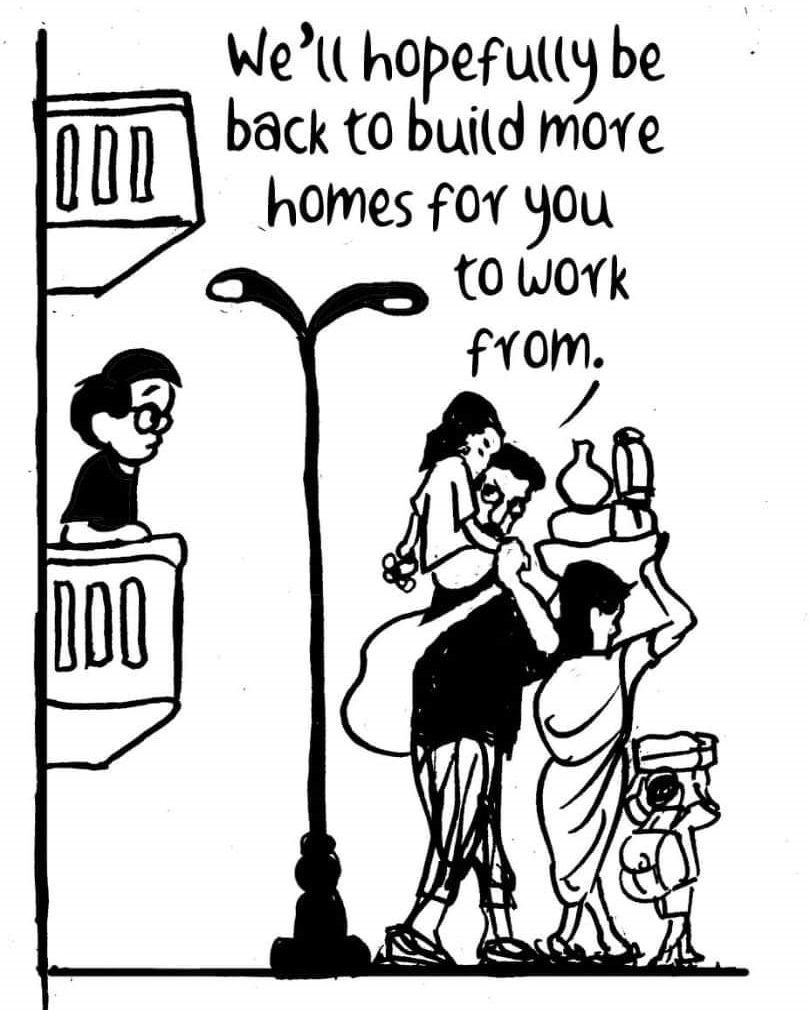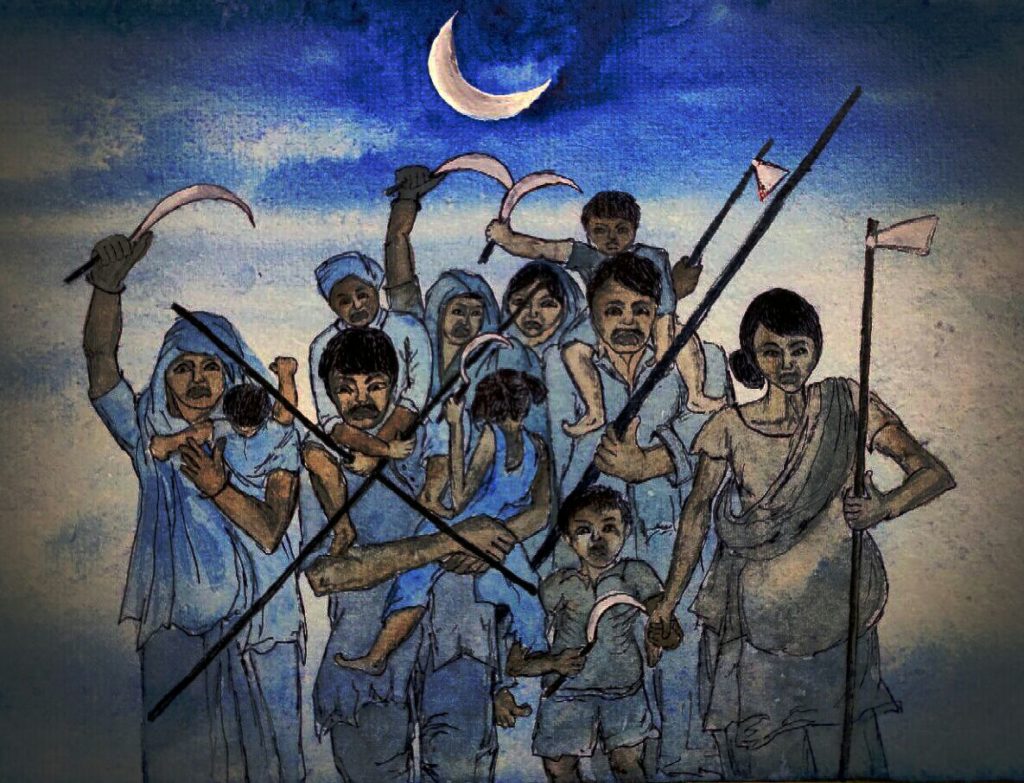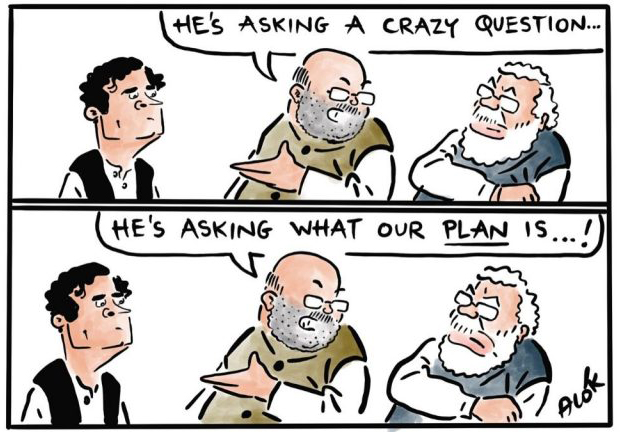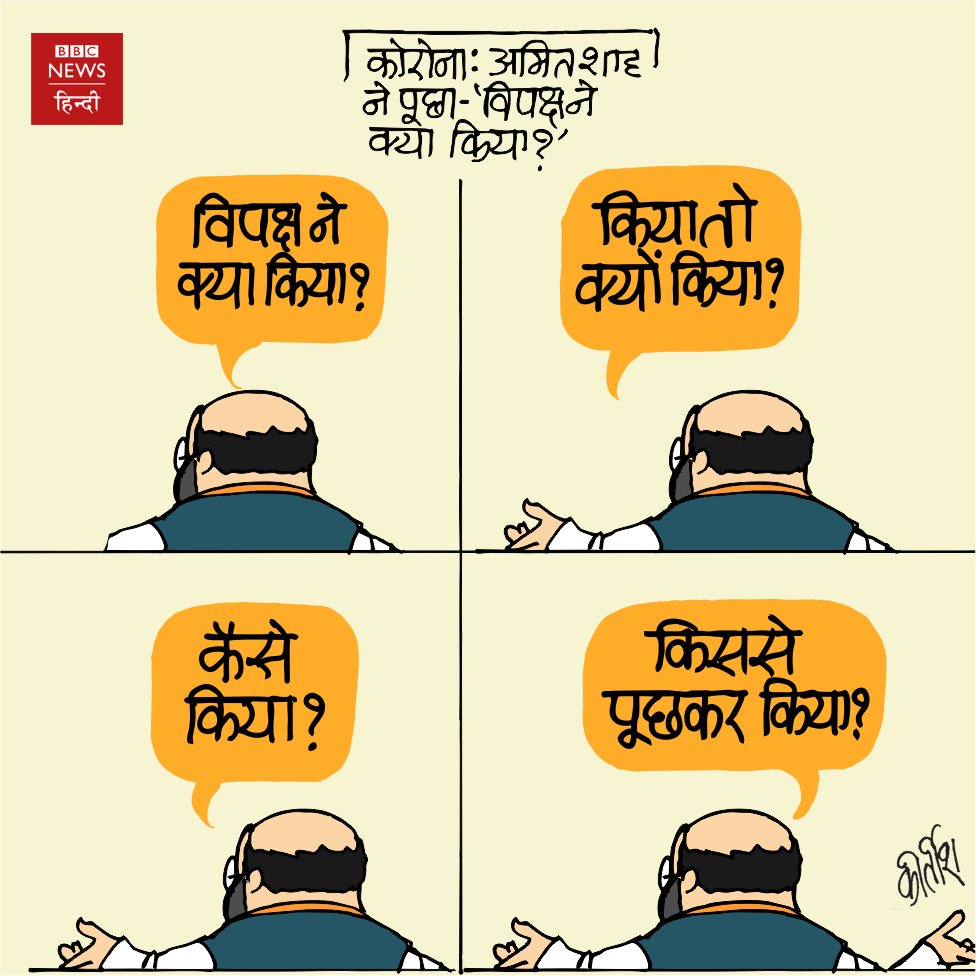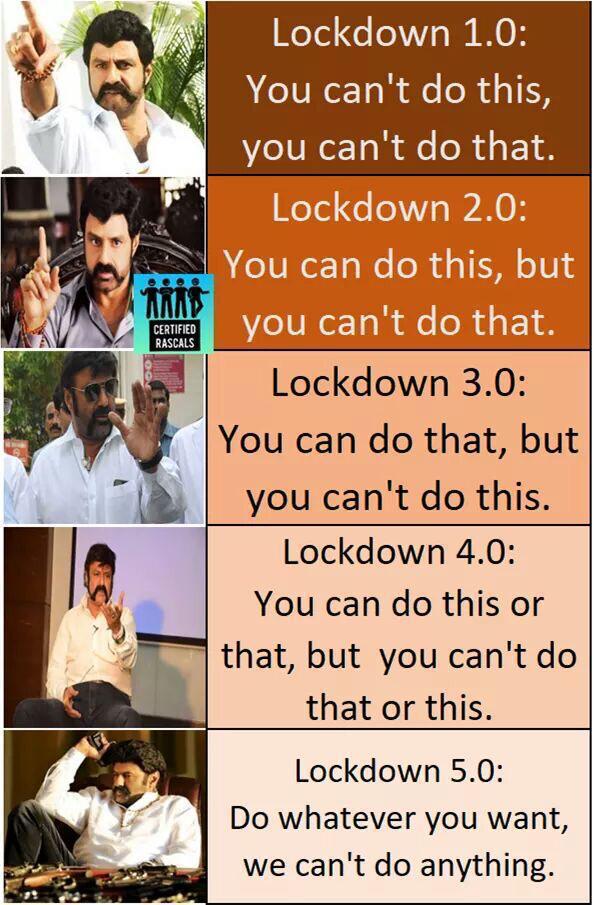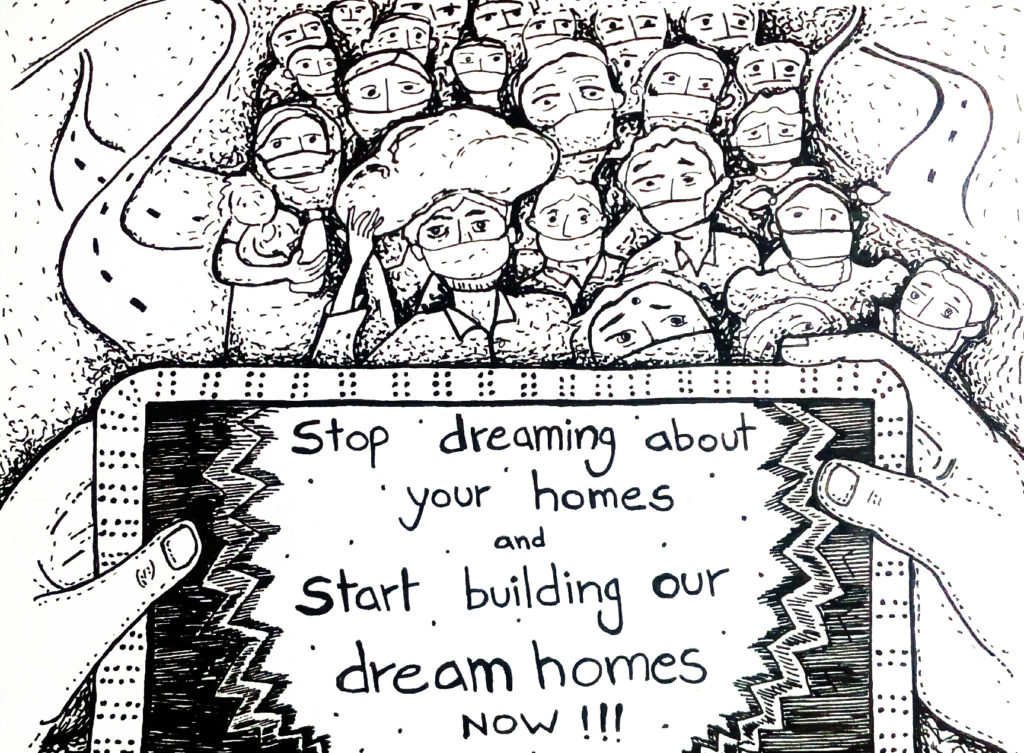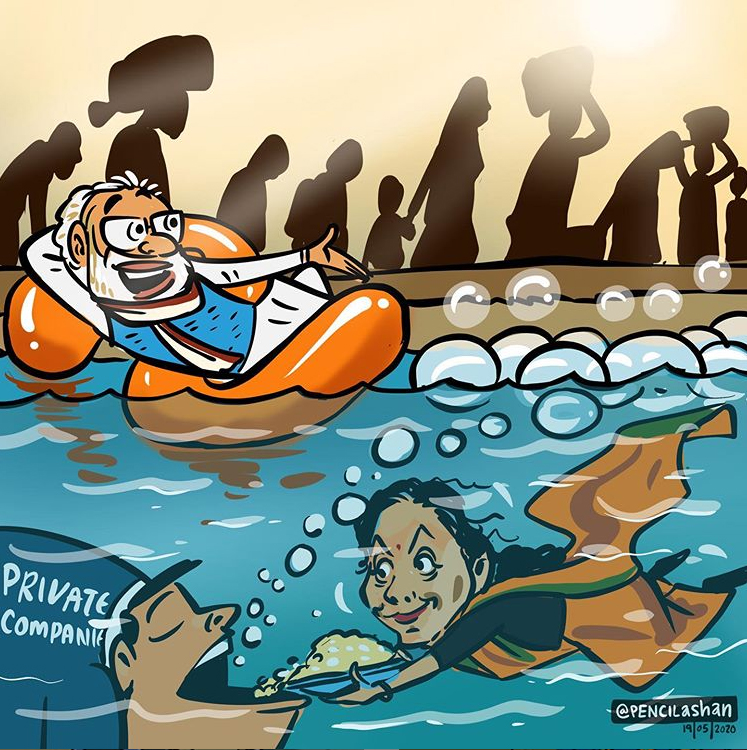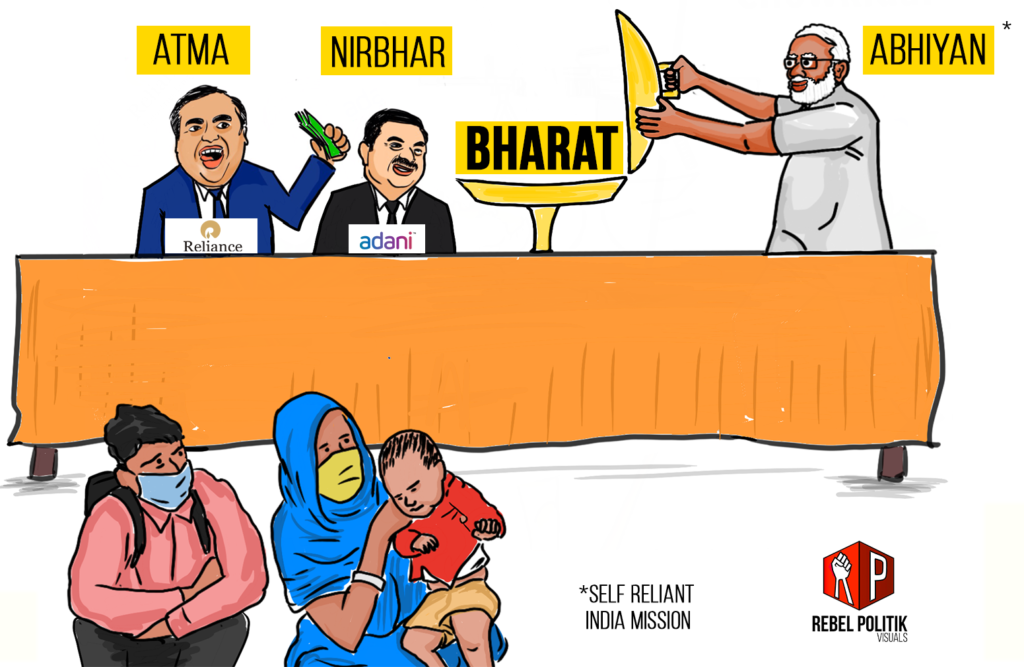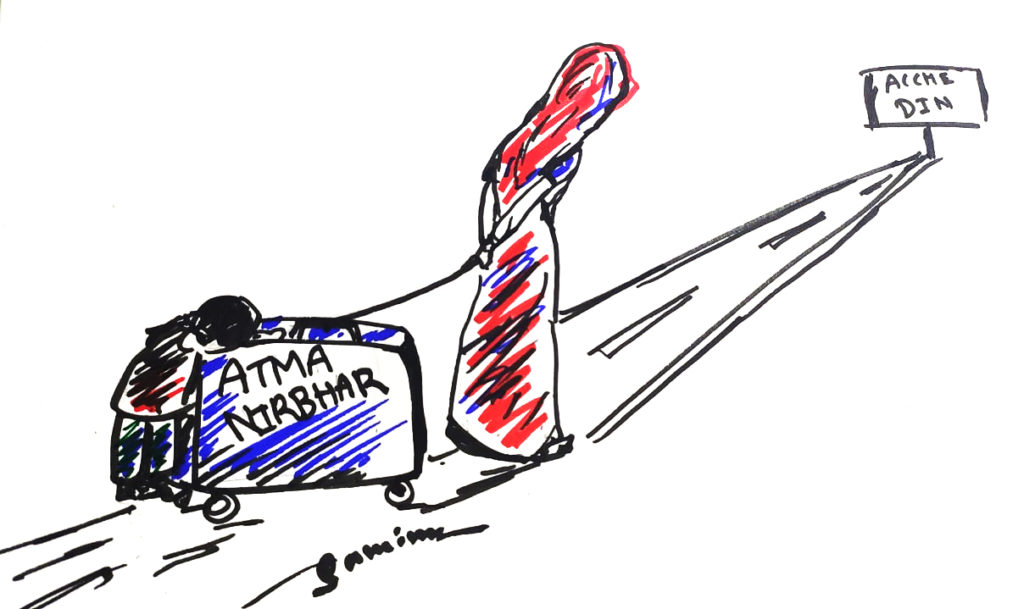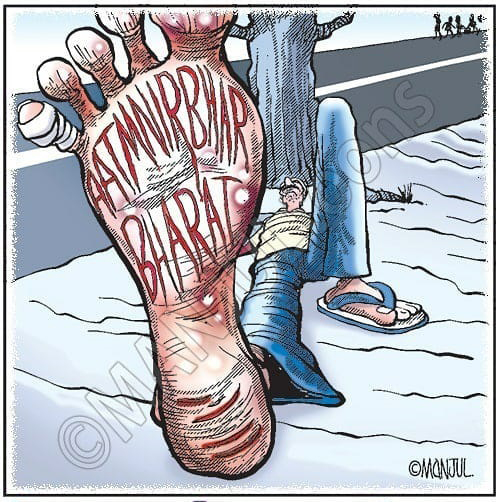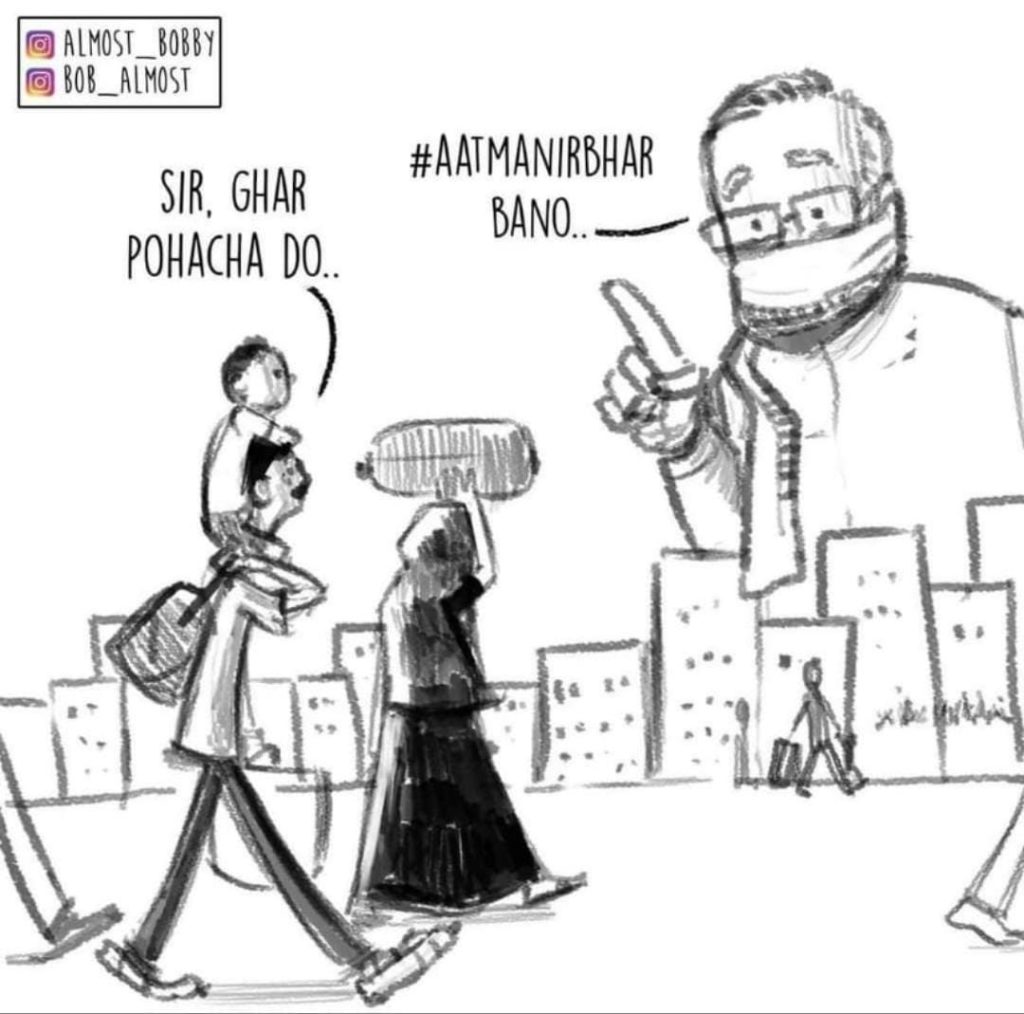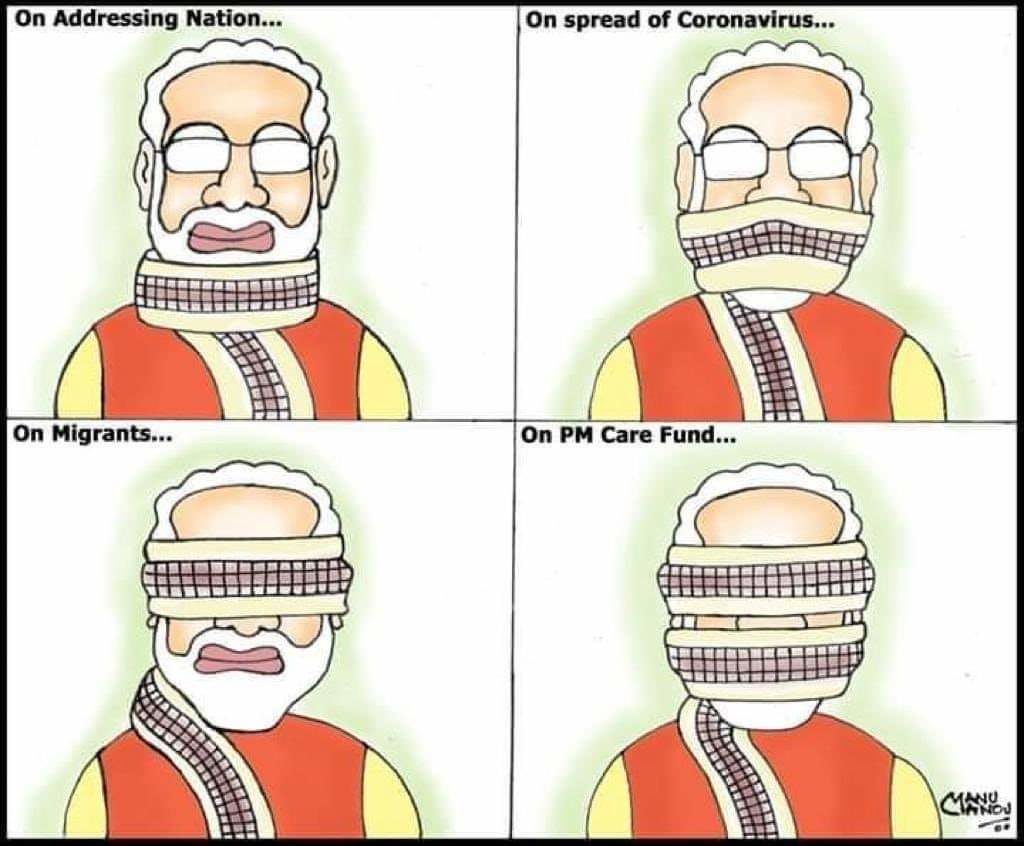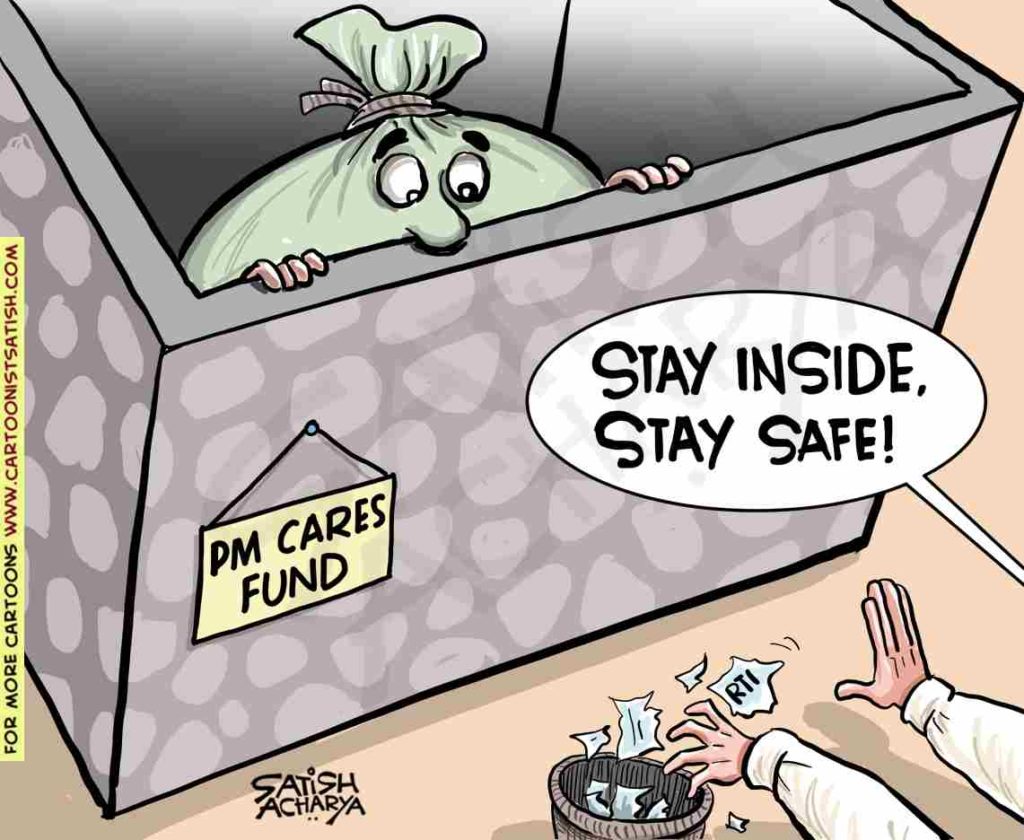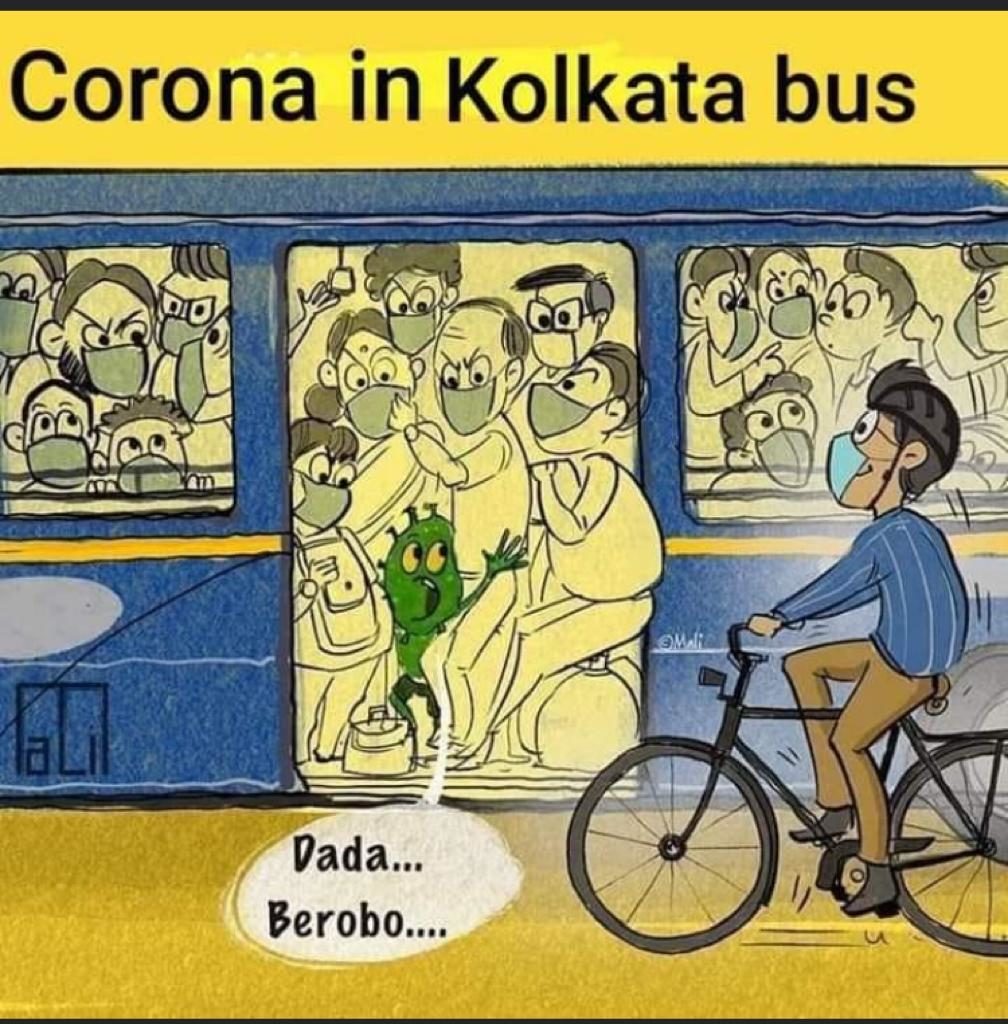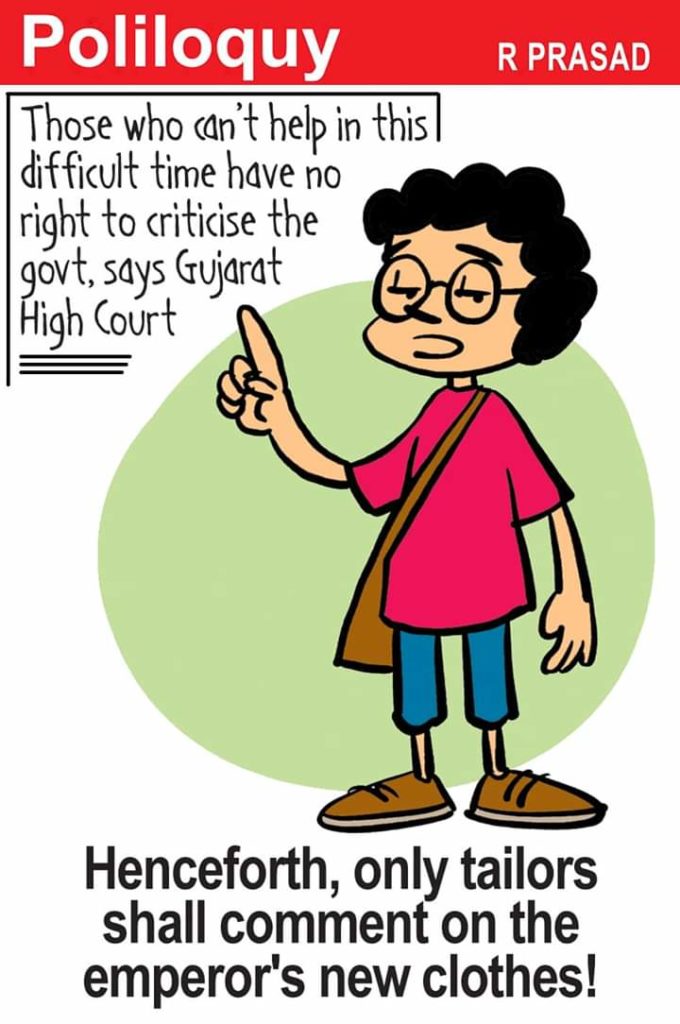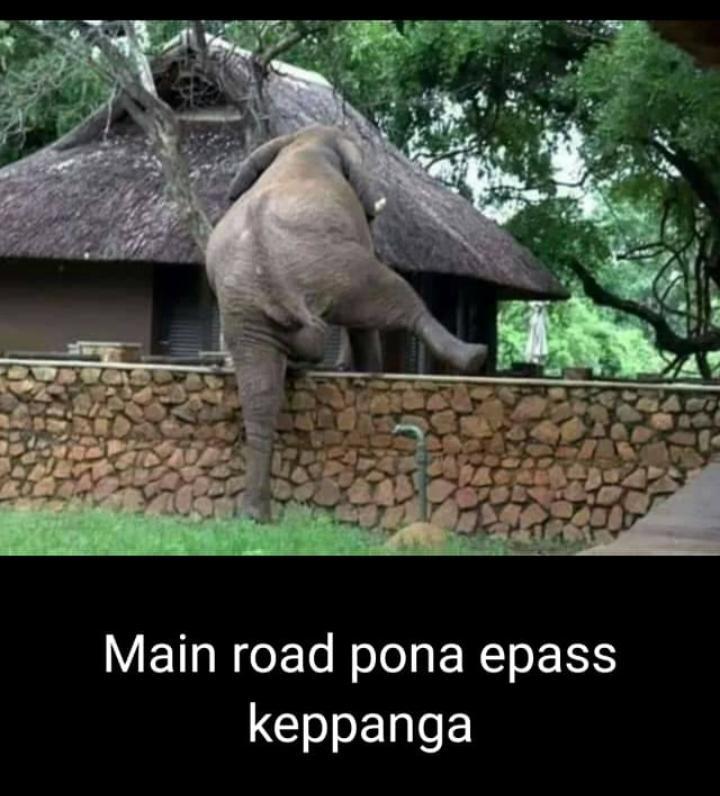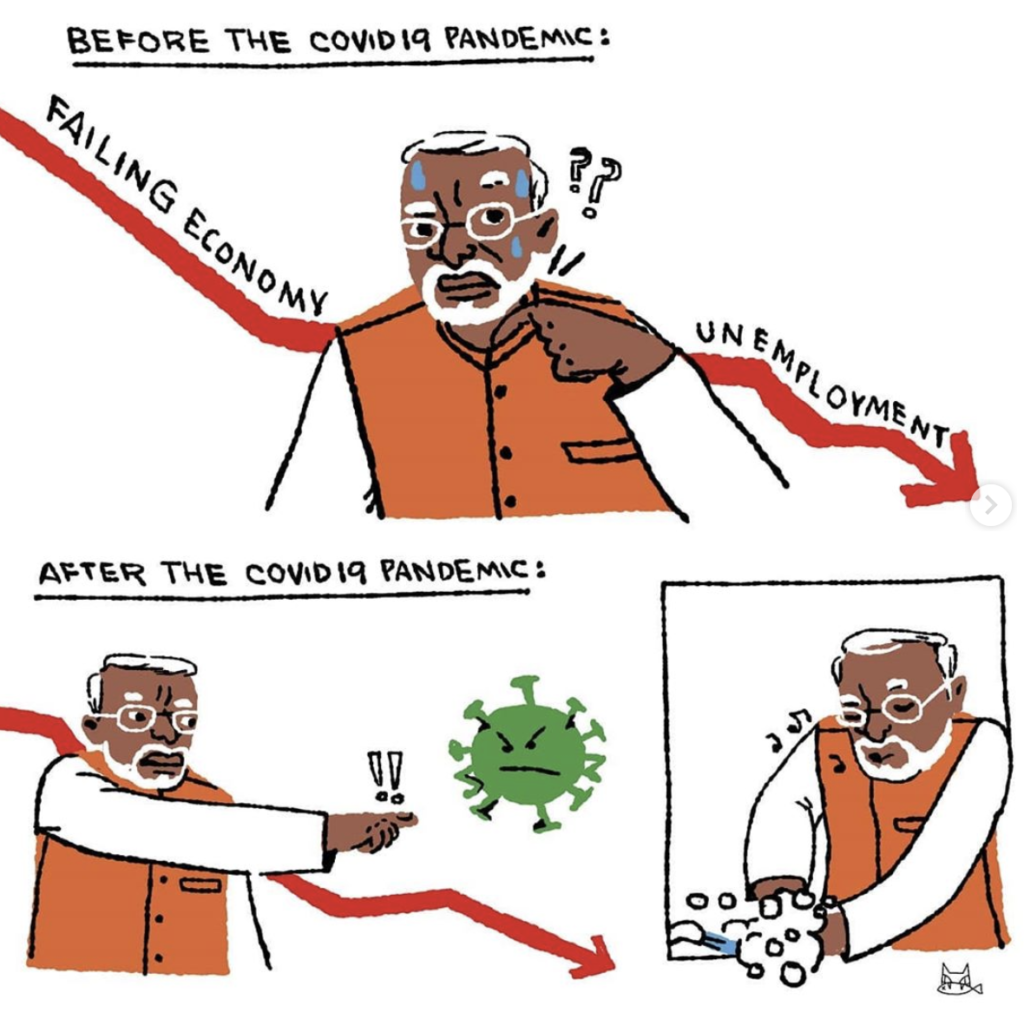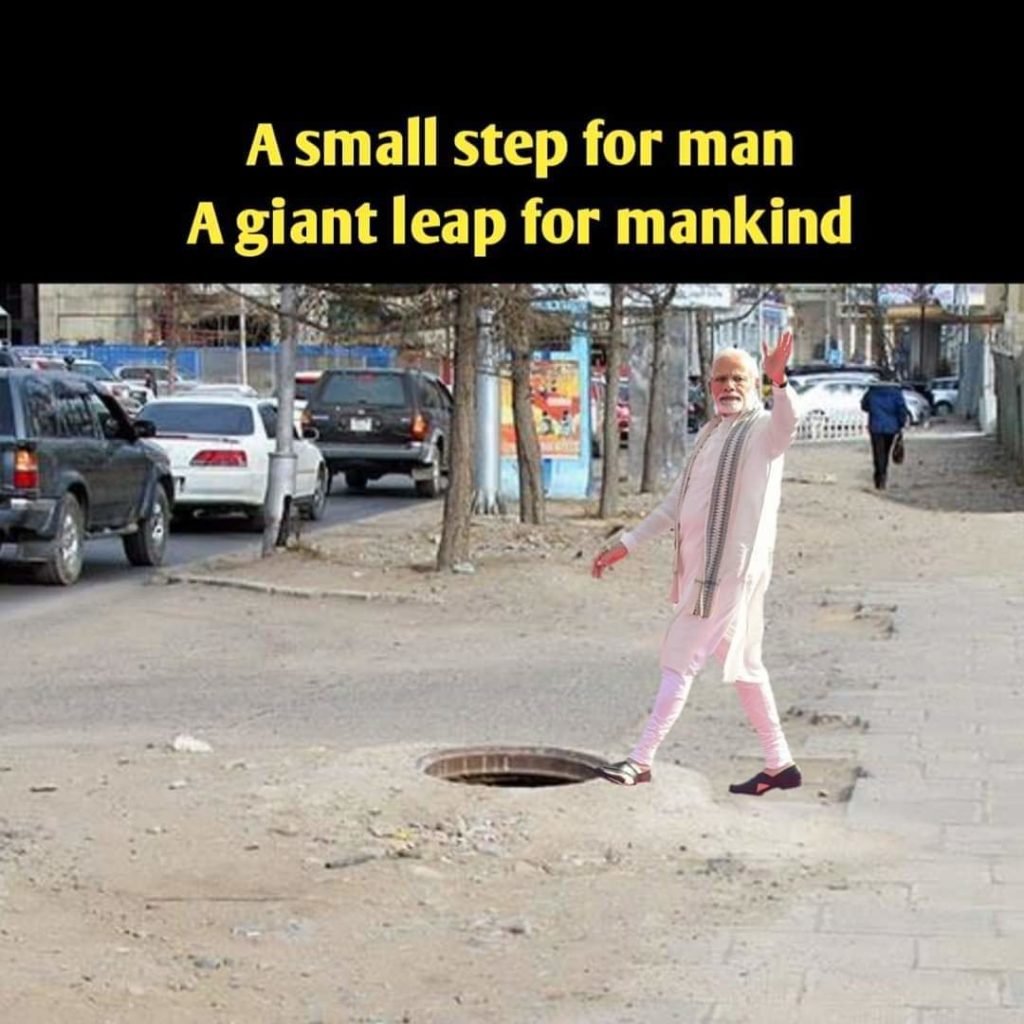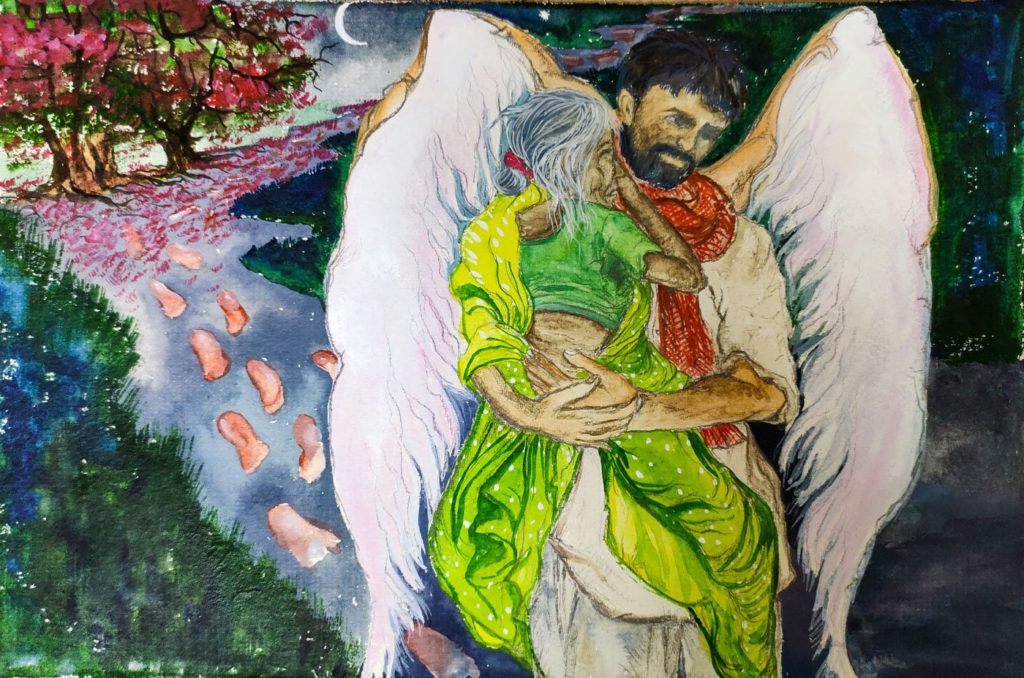Cartoons, memes, infographics, sketches – they document the coronavirus crisis in a unique fashion, capturing the moment in ways that words cannot. Their language is not always politically correct or even appropriate, but they do not lie, and they are often unforgiving. They are weapons of ridicule against the ruling classes. Several online media forums are collecting such images published during lockdown. Many cartoonists such as Sathish Acharya, Manjul, Orijit Sen, Sajith Kumar, Alok Nirantar, P Mahmud, Sarbajit Sen, Saswata Mukherjee, Mansoor Naqvi, Surendra and many others have produced courageous cartoons that went viral on social media. Labani Jangi, Sunil Abhiman Awachar, Vasvi Oza and others have chosen the medium of sketches and paintings to depict these troubled times. Then there are the subversive memes and insightful infographics. Here, we attempt to archive some examples of this “resistance art” – with the focus being cartoons. There are many we could not include and even more we might not have even seen. Our heartfelt thanks are due to all these artists who have been fighting a cruel government through their art.
This is Part 2 of a documentation by GroundXero, which focuses on the government’s response to the pandemic. Part 1 can be read in this link.
The Environment
The coronavirus pandemic generated discussions framing the pandemic against a backdrop of ecological destruction, stating that the pandemic was Nature “fighting back” against human intrusion and irresponsibility. We see the following cartoon from seppo.net expressing a similar sentiment –
It is interesting that attempts are being made to understand the origins of the pandemic by looking first at our own actions as a species. This reflexivity is heartening to see. One can only hope that, in time, it is more widely appreciated that this ecological destruction is carried out not for its own sake – often drawing on some essentialist views of human beings as fundamentally destructive and rotten – but rather at the behest of neoliberal capital.
Indeed, the large-scale clearing of forests, damming of rivers, conducting illegal wildlife trades, and destroying biodiversity – India has done it all! And like other unsustainable and ecologically damaging policy directives of previous governments in India, this program of ecological destruction to benefit the mining and power companies has been turbocharged by the present government, as shown in Karnika Kahen’s cartoon in Sabrang India.
Communalisation and Terror
India and its people are little more than a plaything to the RSS-led BJP government. The group Indian Democracy Matters stated in Countercurrents:
“The routine violation of constitutionally guaranteed rights and autonomy of state governments pose an existential threat to the federal structure of the Indian Republic today. The dismal fate of Kashmir, following the abrogation of Article 370, is a portend of what is in store for all Indian states in the days ahead.”
Cartoonist Sarbajit Sen’s paints a vivid picture of this ominous future, once feared and now lived through:
Sunil Abhiman Awachar’s drawing of a worker carrying various religious symbols on his head makes clear that irrespective of the sense of security the BJP wants to provide to the Hindu working class in India, a time will come when they are honest about how they see the working classes: as a nuisance. On that day, nobody will be spared, as the Draconian lockdown being a small hint.
Subversive cartoons have been used by the right wing as well, of course, to spread the sole agenda item that the BJP is left with now – communalism. They might be lacking genuinity and wit, but they serve the purpose of hate-mongering, though they would not officially be called seditious! Even at a moment of crisis like this their effort to communalise everything was apparent in the case of the brutal death of a pregnant elephant in Kerala. This cartoon published in Clarion India says it all.
On the theme of communalisation, Pencilashan’s depiction of the tragic death of a cow that took place in exactly the same manner as the elephant (in a Hindu locality in Himachal Pradesh) explains how the riot-prone BJP IT Cell functions, goading bigots into violence. It would surprise no one if they read in the papers that the death of a cow had triggered a communal riot or at the very least, generating violent communal hashtags in Twitter. It is the power of these cartoons to speak plainly of the blatant and shameless efforts to demonize Muslims and other minorities that makes our tyrannical government jittery. Many cartoonists now routinely receive threats.
From the point of view of social justice movements, the coronavirus pandemic could not have come at a worse time. From the point of view of our fascist government, it was a blessing: it handed them a get-out-of-jail-free card, a free pass to dismantle the anti-CAA-NRC-NPR agitations that had been building up for months and represented an extraordinary civil society response to discriminatory and unconstitutional laws. Sarbajit Sen’s cartoon captures the mood of Amit Shah and PM Modi as the coronavirus was approaching:
The protests, led by scores of courageous Muslim women all over the country, caused such alarm to the Hindu supremacist government that it had to stage a full-fledged riot (which claimed the lives of over fifty people) to vilify the protesters. The state of Indian democracy was depicted in another cartoon that became popular during lockdown, as the government kept picking up CAA protesters and filing false chargesheets against them.
Corporate Consolidation
Returning to the question of the government’s corporate affinity, one of the first actions to draw the ire of cartoonists was the Rs. 68,000 crore corporate loan waived by the government. This was the same government that mishandled the food and transportation arrangements for millions of migrant workers and argued with the state governments about who would foot the bill for these essentials. These were the same corporates who were finally let free if they didn’t pay their workers for the lockdown period. An unknown artist’s drawing that became a popular WhatsApp forward brought the point home. It was based on yet another woman and her child who became the face of the migrant workers’ plight during this phase.
Children of the poor mother
For what it’s worth, some of the activists made very interesting memes during this period, exposing the companies’ anti-worker policies by tinkering with the companies’ logos.
The corporate loan waiver also came up in Sathish Acharya’s cartoon where he asked the popular question that came up after the government’s announcement of the 20 lakh crore stimulus package. It was all a big zero for the workers!
In occasional cases the workers were paid were few and far between. In general, they were getting shafted by both their employers and the Indian government.
Stuck between Govt. and Corporate : dilution of the labour laws
As mentioned in the above cartoon, the hand-in-hand role of the companies and the government became clear when the labour law reforms were pushed through during the lockdown phase. Vijay Ravikumar’s cartoon for Worker’s Unity shows the scary prospect of workers from Uttar Pradesh returning home only to be faced with 12-hours working days and other dilutions of labour laws that have been fought hard for. (Although the law has now been repealed in UP by an HC order, it remains in several other states.)
Due to lack of means of livelihood at their home states, many workers are now being forced to go back to the workplaces they quit and walked away from in order to get back home, often having to walk hundreds of kilometers or pay a fortune to take a bus. Sarbajit Sen’s drawing shows a dystopian world where the chained workers are walking towards a Mordor-like representation of industry, with many dying on the way.
Protests and Opposition
If not for the protests by workers, activists, and opposition parties, the government would have had a free reign. Interestingly, there were not that many representations of the workers’ anger through cartoons or memes. The workers are, even in the liberal media, still not seen as active protesters but victims of the situation.
A small unnamed cartoon was an exception, though within the borders of the belief that it is still possible to change things by electoral means. The workers are indeed angry – though more at their respective state governments than the central government. It says something about the need to have much more cartoon and other form of visual art campaigns made available to workers that explains the colossal failures of the central government in a humorous vein.
Journalist: Why are you not using your slippers?
Worker: Let the election come and we’ll use them.
Some cartoons gave voices to the workers – voices, which are at least capable of asking a sarcastic question, if not demanding the rights.
Then there were the rare images such as this painting by Labani Jangi that aspired a radical exit from the victimization narrative and offered a metaphor of agency and power.
Whereas the workers and activists could be ignored or silenced by the state, the reaction of the government towards the questions from opposition parties have been clueless and accusatory. Alok Nirantar captures this response perfectly –
This criticism was echoed by BBC News Hindi in a cartoon by Kritish Bhatt –
Amit Shah asked: What did the opposition do? If they did something, why did they do it?
And how did they do it? And whom did they take permission from?
The general air of cluelessness on display by the central government was apparent in the manner in which the various lockdowns were announced and extended, just like this meme says –
To be fair though, we must acknowledge that except for the hard communal line, the rest of the awful governance on display by the BJP is a hand-me-down from the now-opposition Indian National Congress – especially the proclivity to maintain close ties to corporate houses. The BJP is not even hiding it any more. During the lockdown, one of the reasons the government kept acting so clueless was that all the decisions around the migrant worker issue were taken based on the reaction from corporate houses and industry/builder lobbies, as Vasvi Oza’s drawing shows:
Pencilashan’s cartoon spoke about it as well, demonstrating that the Finance Minister was doing the PM’s bidding.
Self-Reliance
The government’s most hilarious and most dangerous pro-corporate anti-worker joke was the Atmanirbhar speech. While it was a prize catch for cartoonist and meme makers, it spoke of a long term plan – total privatization and contractualization. Rebel Politik addresses it in his cartoon.
Horrific scenes from the reverse migration of labour would no longer be an aberration – rather, it would become the norm. The Atmanirbhar India would normalize the mother dragging her sleeping child on a suitcase. Samim Akter Sheikh draws –
It would normalize the photographs of the tattered feet after thousands of kilometers of walking. Draws Manjul.
It would normalize all these plights since all citizens would now be self-reliant and no longer the government’s responsibility. Saswata Mukherjee‘s cartoon makes it clear.
PM Doesn’t Care
The degree to which BJP has embraced privatization and corruption was clear in the curious case of the PM Cares fund. This is, without an iota of doubt, a massive fraud perpetrated against the Indian people. The privatized PM Cares fund that the government blatantly refused to reveal the details of is yet another example of the BJP government’s strategic silence when it comes to subjects it doesn’t want to discuss. Cartoonist Manu Manoj points this out –
Sathish Acharya once more shows his talent at hitting the BJP where it hopefully hurts in this issue as well. The fund is surely dearer to the BPJ than the Indian people, so it’s safer inside, away from the reach of RTIs and inquiries.
Regional Flavour
Several good cartoons came up around regional handling of the corona situation as well. A coronavirus desperately trying to get down from a crowded bus was a jibe at the people of Kolkata failing to maintain physical distancing.
CM Palaniswami was targeted for mismanaging the Shramik trains in Tamil Nadu in a poster.
R. Prasad took a sharp dig at the Gujarat HC, which instead of attempting to control the hospital situation, as instructed by a division bench, set up a new bench which attempted to discourage criticisms of the government’s handling of the hospitalisation crisis.
An unknown meme-maker accurately described the feelings of the migrant workers in Tamilnadu, who were not allowed to travel from one district to another without an e-pass, which had become extremely difficult to get, but without which they could not catch the Shramik trains.
If I take the main road, I’d be asked to show an e-pass.
Accountability
The ruling party might try to wash its hands of all its mistakes and failures, taking advantage of the pandemic and blaming everything on it, but cartoonists like Kruttika Susarla make sure that their skulduggery is documented –
We found another cartoon, although we could not trace its creator, that answers the question that Kruttika’s cartoon asks.
End-note
What these cartoons, infographics, memes and drawings show is that people’s voices cannot be suppressed, and when their creative spirits are unleashed, they create beautiful, funny and powerful images and ideas.
Whether they are memes that makes us laugh,
or paintings (by Labani Jangi, for PARI), which gives us strength and hope even in the time of crisis,
there is little doubt that the medium of images out there, from the social media to the pages of obscure notebooks, is a source of immense power and possibilities.
…
Courtesy: The artists, the online media forums where some of these images were published, Chennai Citizens Covid Fund for Migrant Labour, Migrant Workers Solidarity, Sourav Roy, Pritha Paul.

